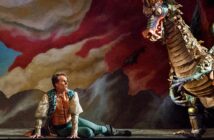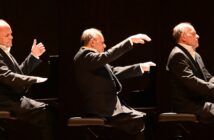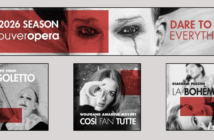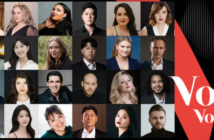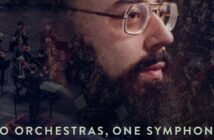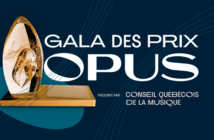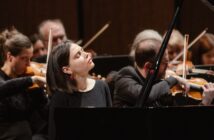This page is also available in / Cette page est également disponible en:
![]() Francais (French)
Francais (French)
After a first webcast concert in October, the Trio Fibonacci will once again return to our screens with Dreams of Tchaikovsky: a foray into the colourful world of Russian music spanning several generations. During this virtual event, which will feature the trios of Tchaikovsky, Shostakovich and Schnittke, the three musicians will to continue their exploration of the trio repertoire while warming the hearts of the public as the holiday season approaches. We caught up with violinist Julie-Anne Derome to learn more about the concert as well as her life during the pandemic.
In April 2018, you presented the Bohemia concert with the trio, dedicated to Czech composers. Can we see your next concert as a continuation of this exploration of the Slavic soul?
There are indeed common points between the two programs. Emotions are expressed so openly and directly, without filters. There are also elements of folk music. The virtuosity of the score brings out the unique colour of each note. It’s a very vibrant sound world! What’s more, in both Bohemia and Dreams of Tchaikovsky, we find works that are part of the same tradition of elegiac trios, notably those by Smetana and Tchaikovsky. These works came about following the loss of a loved one, the composer’s young daughter in the case of Smetana, and his old friend Nikolai Rubinstein in the case of Tchaikovsky. What strikes me about these works is their narrative and biographical aspect. We share the composer’s pain, but also his moments of joy; we enter into the full spectrum of their memories.
You present three very different faces of Russian music through this program. Can you briefly characterize each of the works on the concert?
Shostakovich wrote his First Trio in C minor in 1923, when he was only 16! The work represents an impossible love story. We already perceive something of the bitter character of Shostakovich’s music, but its style is predominantly romantic and impressionist; it’s a wonderful discovery for us. Alfred Schnittke’s Tango is taken from his Concerto Grosso No. 1 for 2 Violins and String Orchestra, written in 1976-77. We made our own adaptation for trio. Schnittke wrote a great deal of music for children’s animated films, and is known for his signature polystylism. With Tango, he wanted to depict his grandmother’s favorite tango, as played on the harpsichord by his great-grandmother. Tchaikovsky’s trio is symphonic in dimensions, to quote the composer himself. This monumental and tragic work, written in one month, from December 1881 to January 1882, is one of these elegiac trios. It is dedicated to his close friend and mentor, Nikolai Rubenstein.
Among these works, is there one that particularly touches you, and why?
All the works touch me, but I can’t deny that the Tchaikovsky trio haunts me. Tchaikovsky had always refused to write a piano trio, even when he was asked by his benefactress Nadezhda von Meck, a businesswoman who supported him for 16 years. It took a personal drama to encourage him to compose for the medium, without anyone actually asking him to. The orchestral and virtuoso aspect of the work stimulates me as a performer. I love the poignant and tragic side of his lyricism. The work, with its many variations, its moments of ballet music, its fugue in the style of Bach, takes us through a story of epic proportions – and nothing in the piano trio literature is quite like the cosmic grand finale!
Playing without an audience must be unsettling. How do you prepare in order to give the best of yourself on stage?
In my opinion, it all hinges on the power of visualization. Our audience would like to be here in the hall with us, and we would like to have them by our side. We imagine them close to us, in thought, in energy, sharing the emotions of this grandiose music. We love our audience very much and we want to create a warm setting where we can share, despite the distance, just like people would come together for musical evenings in private homes and salons in the past.
You recently acquired a new violin as well as a new bow … Can you introduce us to these two new companions?
This violin came into my life unexpectedly. Its velvety sound immediately won me over. It was made by the Australian-born luthier Guy Harrison, who now lives in Ottawa. The violin is a Stradivarius model, which means that it does not like too much bow pressure and offers a wide range of colours. I am learning to discover the depth and the great flexibility of its tone. My new bow is the icing on the cake that makes all the difference. A real magic wand! The bow has the surprising particularity of bringing out the most complex overtones of my violin, which no other bow does. Made at the Hills Workshop in England in the 1920s, its maker was one half of what came to be known as the Gold Squad.
A last word or message to share as we approach these very special holidays?
I believe this period allows us to get back to the basics. You have to make time to do the things you love, surround yourself with your loved ones and take time with them, even if it is virtually. Despite the distance, the warmth and solidarity remain. We have a little Christmas surprise in store for you. Stay tuned! Good health to you all. Let’s come back in force, together, in 2021!
______________________________
Dreams of Tchaikovsky will be broadcast from December 12, 2020 (7:30 p.m.) and will be available for 14 days. Tickets available on https://thepointofsale.com/tickets/reves-de-tchaikovski
This page is also available in / Cette page est également disponible en:
![]() Francais (French)
Francais (French)






